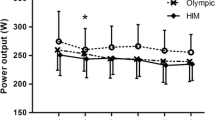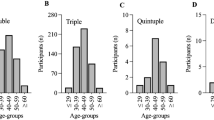Abstract
The aim of this study was to compare the pacing strategies adopted by women and men during a World Cup ITU triathlon. Twelve elite triathletes (6 females, 6 males) competed in a World Cup Olympic distance competition where speed and heart rate (HR) were measured in the three events. The power output (PO) was recorded in cycling to determine the time spent in five intensity zones ([0–10% VT1]; [10% VT1–VT1]; [VT1–VT2]; [VT2–MAP] and ≥MAP) [ventilatory threshold (VT); maximal aerobic power (MAP)]. Swimming and running speeds decreased similarly for both genders (P < 0.05) and HR values were similar through the whole race (92 ± 2 and 92 ± 3% of maximal HR for women and men, respectively). The distribution of time spent in the five zones during the cycling leg was the same for both genders. The men’s speed and PO decreased after the first bike lap (P < 0.05) and the women spent relatively more time above MAP in the hilly sections (45 ± 4 vs. 32 ± 4%). The men’s running speed decreased significantly over the whole circuit, whereas the women slowed only over the uphill and downhill sections (P < 0.05). This study indicates that both female and male elite triathletes adopted similar positive pacing strategies during swimming and running legs. Men pushed the pace harder during the swim-to-cycle transition contrary to the women and female triathletes were more affected by changes in slope during the cycling and running phases.




Similar content being viewed by others
References
Abbiss CR, Laursen PB (2008) Describing and understanding pacing strategies during athletic competition. Sports Med 38:239–252
Atkinson G, Edwards B (1998) Pacing strategy and cycling performance: field data from the 1997 British 16 km time-trial championship (abstract). In: Sargeant AJ, Siddons H (eds) Proceedings of the third annual congress of the European college of sports science. Centre for Health Care Development, Liverpool, p 211
Beaver WL, Wasserman K, Whipp BJ (1986) A new method for detecting anaerobic threshold by gas exchange. J Appl Physiol 60:2020–2027
Bernard T, Vercruyssen F, Mazure C, Gorce P, Hausswirth C, Brisswalter J (2007) Constant versus variable-intensity during cycling: effects on subsequent running performance. Eur J Appl Physiol 99:103–111
Chatard JC, Wilson B (2003) Drafting distance in swimming. Med Sci Sports Exerc 35:1176–1181
Davison RC, Swain D, Coleman D, Bird S (2000) Correlates of simulated hill climb cycling performance. J Sports Sci 18:105–110
Delextrat A, Tricot V, Bernard T, Vercruyssen F, Hausswirth C, Brisswalter J (2003) Drafting during swimming improves efficiency during subsequent cycling. Med Sci Sports Exerc 35:1612–1619
Ebert TR, Martin DT, McDonald W, Victor J, Plummer J, Withers RT (2005) Power output during women’s World Cup road cycle racing. Eur J Appl Physiol 95:529–536
Foster C, Schrager M, Snyder AC, Thompson NN (1994) Pacing strategy and athletic performance. Sports Med 17:77–85
Foster C, deKoning JJ, Hettinga F, Lampen J, Dodge C, Bobbert M, Porcari JP (2004) Effect of competitive distance on energy expenditure during simulated competition. Int J Sports Med 25:198–204
Gardner AS, Stephens S, Martin DT, Lawton E, Lee H, Jenkins D (2004) Accuracy of SRM and power tap power monitoring systems for bicycling. Med Sci Sports Exerc 36:1252–1258
Garland SW (2005) An analysis of the pacing strategy adopted by elite competitors in 2000 m rowing. Br J Sports Med 39:39–42
Hausswirth C, Bigard AX, Berthelot M, Thomaïdis M, Guezennec CY (1996) Variability in energy cost of running at the end of a triathlon and a marathon. Int J Sports Med 17:572–579
Hausswirth C, Bigard AX, Guezennec CY (1997) Relationships between running mechanics and energy cost of running at the end of a triathlon and a marathon. Int J Sports Med 18:330–339
Hausswirth C, Lehénaff D, Dréano P, Savonen K (1999) Effects of cycling alone or in a sheltered position on subsequent running performance during a triathlon. Med Sci Sports Exerc 31:599–604
Hausswirth C, Vallier JM, Lehenaff D, Brisswalter J, Smith D, Millet G, Dreano P (2001) Effect of two drafting modalities in cycling on running performance. Med Sci Sports Exerc 33:485–492
Hausswirth C, Bernard T, Vallier JM, Vercruyssen F, Brisswalter J (2004) Effect of different running strategies on running performance in Olympic distance triathlon. In: Proceedings of the 7th annual congress of the ECSS, Athens, 24–28 July 2002, p 183
Hausswirth C, Le Meur Y, Couturier A, Bernard T, Brisswalter J (2009) Accuracy and repeatability of the Polar® RS800sd to evaluate stride rate and running speed. Int J Sports Med. doi:10.1055/s-0028-1105936
Howley ET, Bassett DR Jr, Welch HG (1995) Criteria for maximal oxygen uptake: review and commentary. Med Sci Sports Exerc 27:1291–1301
Kreider RB, Boone T, Thompson WR, Burkes S, Cortes CW (1988) Cardiovascular and thermal responses of triathlon performance. Med Sci Sports Exerc 20:385–390
Lavoie JM, Montpetit RR (1986) Applied physiology in swimming. Sports Med 3:165–189
Marsh AP, Martin PE (1997) Effect of cycling experience, aerobic power, and power output on preferred and most economical cycling cadences. Med Sci Sports Exerc 29:1225–1232
Robinson S, Robinson DL, Mountjoy RJ, Bullard RW (1958) Influence of fatigue on the efficiency of men during exhausting runs. J Appl Physiol 12:197–201
Suriano R, Vercruyssen F, Bishop D, Brisswalter J (2007) Variable power output during cycling improves subsequent treadmill run time to exhaustion. J Sci Med Sport 10:244–251
Thompson KG, Haljand R, MacLaren DP (2000) An analysis of selected kinematic variables in national and elite male and female 100-m and 200-m. J Sports Sci 18:421–431
Thompson KG, MacLaren DP, Lees A, Atkinson G (2003) The effect of even, positive and negative pacing on metabolic, kinematic and temporal variables during breaststroke swimming. Eur J Appl Physiol 88:438–443
Tucker R, Marle T, Lambert EV, Noakes TD (2006) The rate of heat storage mediates the anticipatory reduction in exercise work rate during cycling in the heat at a fixed perceived exertion. J Physiol 574:905–915
Vandewalle H, Peres G, Heller J, Panel J, Monod H (1987) Force-velocity relationship and maximal power on a cycle ergometer. Correlation with the height of a vertical jump. Eur J Appl Physiol Occup Physiol 56:650–656
Vercruyssen F, Suriano R, Bishop D, Hausswirth C, Brisswalter J (2005) Cadence selection affects metabolic responses during cycling and subsequent running time to fatigue. Br J Sports Med 39:267–272
Vleck VE, Bürgi A, Bentley DJ (2006) The consequences of swim, cycle, and run performance on overall result in elite Olympic distance triathlon. Int J Sports Med 27:43–48
Vleck VE, Bentley DJ, Millet GP, Bürgi A (2008) Pacing during an elite Olympic distance triathlon: comparison between male and female competitors. J Sci Med Sport 11:424–432
Vogt S, Heinrich L, Schumacher YO, Blum A, Roecker K, Dickhuth HH, Schmid A (2006) Power output during stage racing in professional road cycling. Med Sci Sports Exerc 38:147–151
Vogt S, Schumacher YO, Roecker K, Dickhuth HH, Schoberer U, Schmid A, Heinrich L (2007) Power output during the Tour de France. Int J Sports Med 28:756–761
Acknowledgments
This study was supported by technical supports to the French National Institute of Sport and Physical Education, the French Federation of Triathlon and the University of South Toulon-Var. The authors are especially grateful to the athletes and coaches for their help and cooperation. They also gratefully acknowledge the Swiss National Team of Triathlon for their help in the collection of data, and Patricia Vandewalle and Jessica Harrison for their help in the correction of this manuscript.
Author information
Authors and Affiliations
Corresponding author
Additional information
An erratum to this article can be found online at http://dx.doi.org/10.1007/s00421-011-1889-0
Rights and permissions
About this article
Cite this article
Le Meur, Y., Hausswirth, C., Dorel, S. et al. Influence of gender on pacing adopted by elite triathletes during a competition. Eur J Appl Physiol 106, 535–545 (2009). https://doi.org/10.1007/s00421-009-1043-4
Accepted:
Published:
Issue Date:
DOI: https://doi.org/10.1007/s00421-009-1043-4




